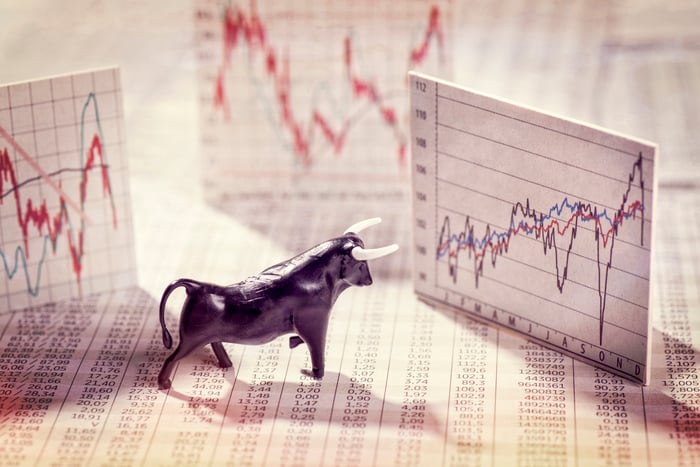Putting your money to work on Wall Street hasn't been for the faint of heart since this decade began. Since the start of 2020, all three major stock indexes have traded off bear and bull markets in successive years, with the growth-driven Nasdaq Composite (^IXIC 2.02%) taking the brunt of the volatility. After losing 33% of its value during the 2022 bear market, the widely followed Nasdaq has surged 54% since the curtain opened on 2023 (as of the closing bell on Feb. 29).
More importantly, this week represented a milestone for the Nasdaq: It officially joined the Dow Jones Industrial Average and S&P 500 in fully putting the 2022 bear market in the rearview mirror. In other words, the Nasdaq Composite climbed to a fresh all-time closing high and decisively declared itself to be in a bull market.

Image source: Getty Images.
Yet in spite of this record close, amazing deals can still be found -- especially when it comes to growth stocks.
What follows are four thrilling growth stocks you'll regret not buying in the new Nasdaq bull market.
Mastercard
The first exceptional growth stock you'll be kicking yourself for not scooping up while the Nasdaq Composite is still relatively early in the latest bull market cycle is payment processing titan Mastercard (MA 0.07%).
Interestingly enough, Mastercard's biggest headwind also tends to be its most prominent catalyst. Financial stocks like Mastercard are cyclical. This is to say, they ebb and flow with the health of the U.S. economy. The thing is, periods of growth last substantially longer than recessions.
Whereas three-quarters of the 12 recessions since the end of World War II resolved in under a year, a majority of expansions have endured multiple years. Buying Mastercard stock and simply being patient will allow investors to take advantage of the natural expansion of the U.S. economy and consumer/enterprise spending over time.
Speaking of expansion, Mastercard is looking at the potential for sustained double-digit earnings growth for as far as the eye can see. It's established itself as the clear No. 2 payment processor by credit card network purchase volume in the U.S. (the largest market for consumption globally), and shouldn't have any trouble expanding organically or acquisitively into underbanked regions of the world, including Southeastern Asia, Africa, and the Middle East.
As I've pointed out, Mastercard's sole focus on payment facilitation is another competitive edge. Although I have little doubt it would be successful as a lender, becoming one would expose the company to credit delinquencies and loan losses. Sticking with payment processing means not having to set aside capital for loan losses, which is a big reason why the company's profit margin has stayed above 40%.
The valuation makes sense as well. While some investors might be scared off by a forward price-to-earnings ratio of 33, the company's outsized earnings growth results in a price-to-earnings-growth ratio (PEG ratio) of less than 1.6. That means there's plenty of upside left in Mastercard for patient, growth-seeking investors.
PubMatic
A second thrilling growth stock you'll regret not purchasing in the young Nasdaq bull market is fast-growing adtech company PubMatic (PUBM 1.75%). Despite shares of PubMatic soaring this past week, abundant upside still remains for investors with a long-term mindset.
Similar to Mastercard, the biggest challenge facing PubMatic is the health of the U.S. economy. PubMatic operates a cloud-based programmatic ad platform that helps publishing companies sell their digital display space. It relies on the willingness of advertisers to spend to drive its business, which ultimately means that it needs the U.S. economy to grow.
But, as noted, periods of growth stick around considerably longer than economic contractions. Historically, this has given ad-driven businesses exceptional long-term pricing power.
What's even more important than a broad-based macro tailwind is that PubMatic is perfectly positioned to capitalize on the digitization of ads in video, mobile, and connected TV. These three channels represent sustained double-digit growth opportunities through at least the midpoint of the decade, if not well beyond. CEO Rajeev Goel noted in the company's fourth-quarter operating results, "We believe we are at the early stages of a period of significant multiyear revenue growth and market share expansion."
The true turning point for PubMatic was the decision to build out its own cloud-based infrastructure, rather than relying on a third-party platform. As the company's sales have scaled, it's been able to hang on to more of its revenue. In short, it's a recipe for higher margins over time.
With its cash flow liable to soar in the coming years and the company's board recently approving a $100 million share repurchase program, all signs point to healthy upside to come for PubMatic.

Image source: Getty Images.
Exelixis
The third eye-catching growth stock you'll regret not adding to your portfolio with the Nasdaq finally pushing to a new all-time high is biotech stock Exelixis (EXEL 0.72%). Though Exelixis has a concentrated drug portfolio that's heavily reliant on sales from Cabometyx, there are numerous catalysts working in the company's favor.
The most exciting development for Exelixis is potential label expansion opportunities for Cabometyx. Already approved to treat first- and-second-line renal cell carcinoma and advanced hepatocellular carcinoma, positive late-stage trials involving cabozantinib (the scientific name for Cabometyx) for patients with advanced pancreatic and extra-pancreatic neuroendocrine tumors, as well as patients with metastatic castration-resistant prostate cancer (in combination with Roche's Tecentriq), offer plenty of hope for expanded revenue streams in the years to come. Exelixis is working on dozens of clinical studies involving Cabometyx as a stand-alone or combination cancer treatment.
The abundant cash flow generated from the sale of Cabometyx has also allowed the company to reignite its internal growth engine. It's developing and advanced a couple of novel therapies into early clinical trials, and has forged a few collaborations to develop cancer therapeutics. By the latter half of the decade, Exelixis should see a well-diversified drug portfolio.
Investors needing another reason to pounce on Exelixis' stock need look no further than its exorbitant cash position. It closed out 2023 with $1.72 billion in cash, cash equivalents, and investments, which represents more than enough capital to fuel internal innovation, collaborations, and possibly even acquisitions.
The final piece of the puzzle with Exelixis is its inexpensive valuation. Between 2023 and 2027, Wall Street's consensus expects Exelixis to nearly quadruple its earnings per share. A multiple of just 15 times forward-year earnings is a bargain for this drug developer.
Amazon
The fourth thrilling growth stock you'll regret not buying in the new Nasdaq bull market is none other than e-commerce behemoth Amazon (AMZN 3.43%). Despite a few money-based metrics and predictive indicators suggesting the U.S. could fall into a recession, Amazon looks perfectly positioned to thrive in the years to come.
Most investors are familiar with Amazon because of its world-leading online marketplace. If the U.S. were to dip into a recession, e-commerce sales would be expected to decline.
However, Amazon generates very little of its operating income and cash flow from its low-margin online marketplace. The bulk of the company's cash flow and income originates from its ancillary operating segments, which includes Amazon Web Services (AWS), advertising services, and subscription services. These segments have shown no signs of slowing down.
AWS is the world's leading cloud infrastructure service platform. Enterprise cloud spending is still in its relative infancy, which bodes well for Amazon to sustain double-digit growth from this all-important, high-margin segment. Even though AWS generates only a sixth of the company's sales, it was responsible for 67% of Amazon's $36.9 billion in operating income last year.
Meanwhile, advertising services has sustained at least a 22% year-over-year growth rate, looking back to the September 2022-ended quarter. Amazon is attracting in excess of 2 billion monthly visitors, many of which are motivated shoppers. This affords the company exceptional pricing power from merchants who want to get their message(s) in front of users.
Subscription services is maintaining a growth rate of at least 13% on a year-over-year basis, too. Amazon surpassed 200 million global Prime subscriptions in April 2021 and has likely added to this figure. Prime is an invaluable tool that helps keep users within its ecosystem of products and services.
You might also be surprised to learn that Amazon is historically inexpensive relative to its cash flow. Opportunistic investors can grab shares right now for less than 13 times forward-year cash flow, which is well below the multiple of nearly 23 times cash flow Amazon has averaged over the trailing-five-year period.





